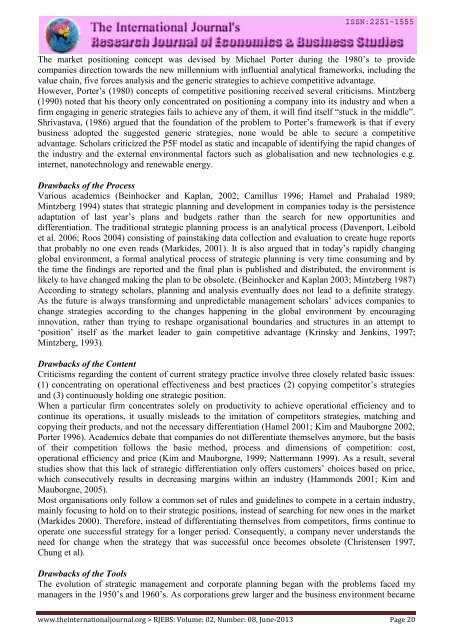Research Journal of Economics & Business Studies - RJEBS - The ...
Research Journal of Economics & Business Studies - RJEBS - The ...
Research Journal of Economics & Business Studies - RJEBS - The ...
- No tags were found...
You also want an ePaper? Increase the reach of your titles
YUMPU automatically turns print PDFs into web optimized ePapers that Google loves.
<strong>The</strong> market positioning concept was devised by Michael Porter during the 1980’s to provide<br />
companies direction towards the new millennium with influential analytical frameworks, including the<br />
value chain, five forces analysis and the generic strategies to achieve competitive advantage.<br />
However, Porter’s (1980) concepts <strong>of</strong> competitive positioning received several criticisms. Mintzberg<br />
(1990) noted that his theory only concentrated on positioning a company into its industry and when a<br />
firm engaging in generic strategies fails to achieve any <strong>of</strong> them, it will find itself “stuck in the middle”.<br />
Shrivastava, (1986) argued that the foundation <strong>of</strong> the problem to Porter’s framework is that if every<br />
business adopted the suggested generic strategies, none would be able to secure a competitive<br />
advantage. Scholars criticized the P5F model as static and incapable <strong>of</strong> identifying the rapid changes <strong>of</strong><br />
the industry and the external environmental factors such as globalisation and new technologies e.g.<br />
internet, nanotechnology and renewable energy.<br />
Drawbacks <strong>of</strong> the Process<br />
Various academics (Beinhocker and Kaplan, 2002; Camillus 1996; Hamel and Prahalad 1989;<br />
Mintzberg 1994) states that strategic planning and development in companies today is the persistence<br />
adaptation <strong>of</strong> last year’s plans and budgets rather than the search for new opportunities and<br />
differentiation. <strong>The</strong> traditional strategic planning process is an analytical process (Davenport, Leibold<br />
et al. 2006; Roos 2004) consisting <strong>of</strong> painstaking data collection and evaluation to create huge reports<br />
that probably no one even reads (Markides, 2001). It is also argued that in today’s rapidly changing<br />
global environment, a formal analytical process <strong>of</strong> strategic planning is very time consuming and by<br />
the time the findings are reported and the final plan is published and distributed, the environment is<br />
likely to have changed making the plan to be obsolete. (Beinhocker and Kaplan 2003; Mintzberg 1987)<br />
According to strategy scholars, planning and analysis eventually does not lead to a definite strategy.<br />
As the future is always transforming and unpredictable management scholars’ advices companies to<br />
change strategies according to the changes happening in the global environment by encouraging<br />
innovation, rather than trying to reshape organisational boundaries and structures in an attempt to<br />
‘position’ itself as the market leader to gain competitive advantage (Krinsky and Jenkins, 1997;<br />
Mintzberg, 1993).<br />
Drawbacks <strong>of</strong> the Content<br />
Criticisms regarding the content <strong>of</strong> current strategy practice involve three closely related basic issues:<br />
(1) concentrating on operational effectiveness and best practices (2) copying competitor’s strategies<br />
and (3) continuously holding one strategic position.<br />
When a particular firm concentrates solely on productivity to achieve operational efficiency and to<br />
continue its operations, it usually misleads to the imitation <strong>of</strong> competitors strategies, matching and<br />
copying their products, and not the necessary differentiation (Hamel 2001; Kim and Mauborgne 2002;<br />
Porter 1996). Academics debate that companies do not differentiate themselves anymore, but the basis<br />
<strong>of</strong> their competition follows the basic method, process and dimensions <strong>of</strong> competition: cost,<br />
operational efficiency and price (Kim and Mauborgne, 1999; Nattermann 1999). As a result, several<br />
studies show that this lack <strong>of</strong> strategic differentiation only <strong>of</strong>fers customers’ choices based on price,<br />
which consecutively results in decreasing margins within an industry (Hammonds 2001; Kim and<br />
Mauborgne, 2005).<br />
Most organisations only follow a common set <strong>of</strong> rules and guidelines to compete in a certain industry,<br />
mainly focusing to hold on to their strategic positions, instead <strong>of</strong> searching for new ones in the market<br />
(Markides 2000). <strong>The</strong>refore, instead <strong>of</strong> differentiating themselves from competitors, firms continue to<br />
operate one successful strategy for a longer period. Consequently, a company never understands the<br />
need for change when the strategy that was successful once becomes obsolete (Christensen 1997,<br />
Chung et al).<br />
Drawbacks <strong>of</strong> the Tools<br />
<strong>The</strong> evolution <strong>of</strong> strategic management and corporate planning began with the problems faced my<br />
managers in the 1950’s and 1960’s. As corporations grew larger and the business environment became<br />
www.theinternationaljournal.org > <strong>RJEBS</strong>: Volume: 02, Number: 08, June-2013 Page 20

















